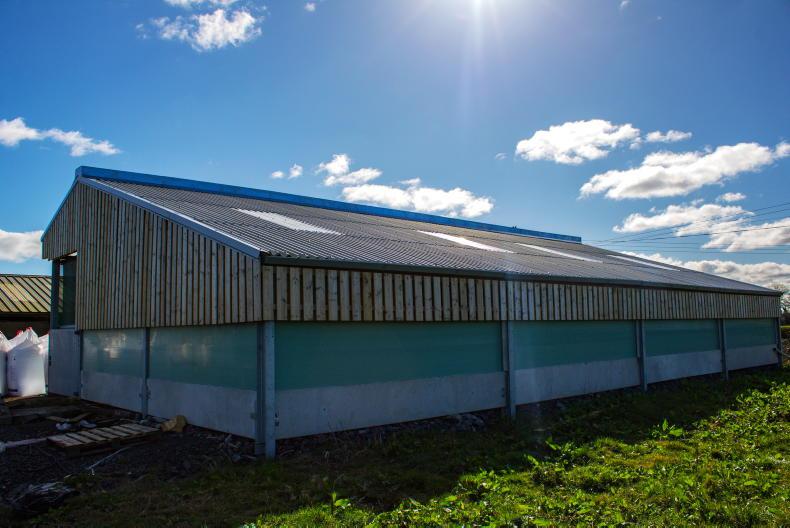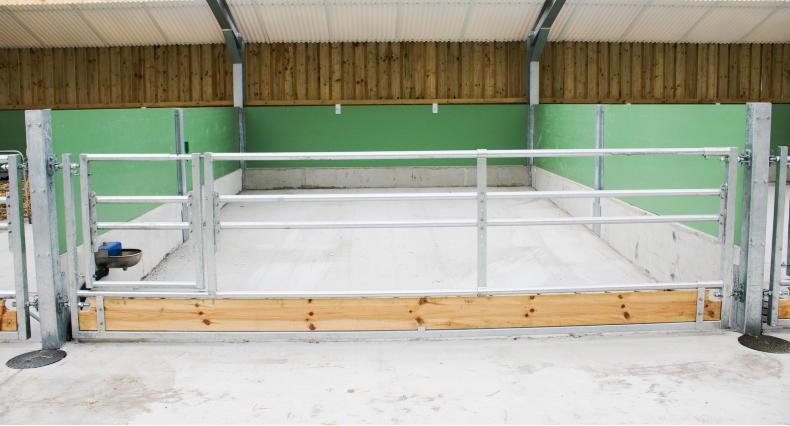For Brendan and Liam Garry, the Teemore Mono Calf Building is transformative, eliminating health issues, improving calf growth, making farm management more efficient.
The superior design and expert construction of the shed provides an optimal environment for calf health and growth, bringing calf welfare to a new level.
Farming in partnership outside Clonmellon in County Westmeath, the father and son duo operate a split-calving dairy herd with 70% spring and 30% autumn calving.
“We are about 60% way through calving, we got a bad doing with TB last year, so we were slow to start and had less to calve,” Liam explained.
“All the breeding stock are bred to AI. The heifers and young cows are given sexed semen and the rest are put in calf to a Charolais or Angus bull.
“We keep all our calves and finish our beef cattle at two years old. We started to use high CBV bulls last year, so those calves are on the ground now and so far, so good.”
Shed

With a growing herd and increasing pressure on existing facilities, the Garry’s knew they needed a dedicated calf shed.
“We had no designated calf shed and it was badly needed. We looked at a few different sheds, and got in contact with Teemore last spring,” Liam said.
“Teemore supplied the steel, roof, all fittings, barriers, precast walls, and tank. We got the shed erected and fitting and fixtures done and had it ready for the autumn calves last year.”
Ventilation and design
Designed by ventilation expert Jamie Robertson, the shed ensures strong early development while making management easier for farmers.
Effective ventilation is crucial in preventing pneumonia and other respiratory diseases, as airborne bacteria significantly contribute to calf health issues.
The building was strategically positioned with the back towards the southwest to maximise the natural ventilation features in the design.
Yorkshire boarding on the back of the shed and an open protected ridge at the top mean that when the prevailing wind hits the rear of the building it then rises up the roof creating negative pressure inside the shed drawing the stale air and moisture out of the top ridge.
Gale breaker roller screens at the front of the shed allow access into pens, and provides additional ventilation and light.
Adequate ventilation in calf sheds can be difficult to achieve on still days. Turned on by a switch, the ventilation tube guarantees fresh air distribution evenly throughout the building regardless of the external weather conditions.
Gale Breaker vent tubes are designed using the Wisconsin calculation system, ensuring air is refreshed five to six times per hour while preventing draughts at calf level.
“We find the ventilation tube very good for keeping the moisture out and providing a nice warm climate any day of the year,” Liam noted.
The fibre cement roof reduces condensation, while the plastic walls between the pens help retain heat, creating a warmer environment for the calves compared to concrete
Labour efficient
The four-bay shed is designed for easy access, streamlining feeding and handling while improving workflow efficiency. This makes daily tasks simpler and reduces the effort required for calf care.
Since its installation, calf management has become faster, cleaner, and more efficient. The improved layout reduces disease risk, allows for easier cleaning, and has significantly decreased the daily workload.
“The shed is easy to bed and clean with little to no disease, it is very labour efficient,” Liam commented.
“Each pen accommodates 15-20 calves and is individual, ensuring that cleaning one pen does not disrupt the others, which is essential from a disease management perspective.”
To maintain a dry and hygienic environment, the shed features an integrated drainage system, including a small precast tank at the front to collect runoff, saliva, or spilt milk, preventing contamination of bedding.
Calf management

Calves receive transition milk for the first week before being moved to the new shed, where they are grouped by size and fed milk replacer and crunch.
At eight weeks, they transition to once-a-day feeding until they are weaned at 10-12 weeks and turned out to grass
“Teemore were very easy to deal with,” remarked Liam. “The shed was delivered very quickly and they were easily contactable with questions or issues.”
“The pillars came two weeks after the deposit was put down, and the whole shed was delivered within a month of being ordered.
“Before this, we were using other sheds, we had to use calving pens and the yard was under pressure, but now we have great comfort,” Liam explained.
“I would recommend the shed to any farmer looking to put up a calf shed. We haven’t had one case of pneumonia or scour in it. It’s a state-of-the-art building and the calves seem very happy and are performing well.”
The stress-free environment encourages stronger, healthier calves, with improved growth rates and the low-maintenance design ensures years of reliable performance.
For any farmer looking to improve calf health, reduce disease risk, and simplify management, the Teemore Mono Calf Building is an investment that pays off.
With its cutting-edge ventilation, ease of use, and rapid installation, it is helping farmers like the Garry’s achieve better results with less effort.







 This is a subscriber-only article
This is a subscriber-only article





